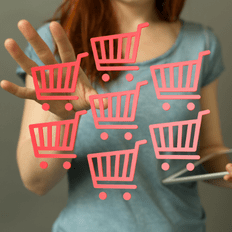Can’t decide between Shopify or Etsy? Want to know which technology will help your business compete? We’ll help answer these questions and more in our first blog of 2021! But first, cast your mind back….
Ahh the lead up to Christmas 2020, streets full of people searching eagerly for last-minute gifts, snow falling, carol signers, the smells, the tastes, and the vendors selling all manner of beautifully handmade goods. Except this year there weren’t any vendors, or at least there were far fewer, as Coronavirus restrictions took hold.
There is a solution = sell online. Coronavirus has accelerated the shift to online by 5 years. eCommerce is the way forward, and retailers need to choose wisely to get the right technology for their business. But which to choose – a marketplace or website? Shopify vs Etsy?
If you’re an eCommerce retailer or an aspiring one, you’ve almost certainly heard of these two stellar brands. Both have great features, enabling retailers to sell online. However, there are big differences between the two, and both have benefits and weaknesses. In this blog, we’ll try to give you a rounded view of it all.
What is covered in this article:
What’s the Difference Between Shopify and Etsy?
- What is Etsy?
- What is Shopify?
- Ease of Use
- Design
- eCommerce Tools and Features
- Pricing
- Marketing and SEO
- Help and Support
- Choosing
What’s the Difference Between Shopify and Etsy?
Shopify and Etsy are different. Like Amazon, eBay, and Alibaba, Etsy is a marketplace. Etsy is touted as a “creative marketplace”, where customers can buy directly from “creative entrepreneurs’- that could be you? And the platform supports vendors who sell handmade, vintage, or craft goods. Whereas Shopify is a fully formed website platform with an array of sales, inventory, and marketing features providing you the opportunity to customize your site.
What is Etsy
Created in 2005, Etsy is the number 1 marketplace for selling handmade goods. It is quite simple to use and showcases your products on it’s beautifully clean, customer-friendly site, which happens to have a huge audience. There are 3 million sellers, selling to 50 million humans- which equates to just short of 5 billion in sales. Not bad for a store set up to provide space for handmade goods and crafts!
Etsy has 3 main versions:
Etsy standard – no-frills entry-level Etsy. Set up an account, upload products, link to your bank account, and get selling.
Etsy Plus – Comes with all the standard features, plus credits for Etsy Ads, customization features, and discounts on packaging and promotional materials.
Etsy Pattern – lots more customization; themes, color schemes, typography, and logos, and your own semi-personalized domain http://yourstore.patternbyetsy.com/.
What is Shopify?
Shopify was released in 2006, and touted as a platform that can give you an operational website in 10 minutes- yes 10 minutes! Shopify has gone from strength to strength, this “all-in-one” solution is easy to use and doesn’t require a high level of expertise to work.
- 3rd biggest eCommerce platform.
- 20% of eCommerce platforms use it
- There’s a 126% year upon year growth for Shopify merchants.
Native features include templates, themes, payment processor, blogging capabilities, unlimited products, unlimited bandwidth, Shopify point of sale, online sales channels, discount codes
overview dashboard, customer support to name a few.
Shopify does come in three different versions providing a service for small- to international size businesses- Shopify Basic, Shopify, and Shopify Advanced. For the purpose of this article, we’ll focus on the basic version.
Ease of Use
Smooth and hassle-free are words every eCommerce retailer wants to hear. An easy to use system mean less time setting up and managing, and instead means more time to focus on things like marketing and selling goods. Etsy vs Shopify, how do they stack up?
Shopify has a clean, easy-to-navigate interface, which allows fairly painless setup and management- which is bonus for something so powerful. I say “fairly” as it depends on how much you want from your website, the greater knowledge you have the further you can go. Do you need extensive coding knowledge- no, would it help- yes.
You also have the ability to sync inventory, order tracking, and more- anything which can be synced saves you time and effort. Shopifys drag and drop system also enables you to customize things with minimal effort.
Etsy on the other hand makes Shopify look complicated- which is a hard task. Being a marketplace Etsy doesn’t come with the same arsenal of features, however, it does allow you a quick and easy way to sell online. Simply, set up an account, stock your store, link your store to your bank account and off you go. When setting up your account, Etsy will provide suggestions on how you can arrange everything. Unlike Shopify, there isn’t much to customize, but if you do get stuck there are articles, forums, and a support center to assist.
When it comes to user reviews it’s hard to split the two with Etsy scoring a 4.5 /5 for ease of use and Shopify 4.5/ 5.
Design
Design matters. Have you ever entered a store, and wondered who designed it and what were they thinking? 75% of businesses’ credibility comes from its design, and 38% will leave the store if they’re not impressed- taking their money with them! So is it Etsy or Shopify when it comes to design?
When choosing Etsy your store will follow the Etsy design and layout. All seller pages on Etsy are laid out the same, your logo, name, products, and descriptions are the aspects which allow for some individuality. The design and layout of Etsy is clean, clear and intuitive- Etsy does a great job of marketing products, and it’s within Etsy’s interest that they make sure their site and your products look amazing. Combine that with amazing user experience (UX)- and you have a winning product and 5 billion + sales made this year! People vote with their feet, or hands.
I’m not glossing over the fact that it’s a real challenge to stand out from the crowd with Etsy. The inability to customize your shop could potentially harm your brand- diluting your once strong brand identity- that’s if you already have one. If you haven’t then there’s little worry about.
Shopify on the other hand comes with 70 themes, 10 of which are free, with themes costing between $140-180. Each theme comes mobile-responsive and oozes quality. Themes are also broken down into industries from Art, to food and drink, to health and beauty- features differ depending on the theme you choose. It’s this level of flexibility that means you can build a store that carries your brand identity, stands out from the crowd, and draws consumers’ attention-something Etsy struggles with.
Domain name
First of all, why do domain names matter? A domain name is your website address, it’s one of the most important parts of your brand. It’s fundamental in building; trust, brand awareness, and can help your business rank higher in searches.
Shopify has a dedicated service enabling you to search, find, and choose your own domain name. You can register your domain name through Shopify, with automated setup, and no configuration needed.
With Etsy, you don’t have the option of a domain name, well at least not with the standard Etsy. But is this such a problem? Starting in 2005, Etsy has a loyal customer base, with 83% of users making repeat purchases. Etsy is a household name and has become synonymous with the handmade goods industry. The Etsy name already carries with it the qualities of a big brand-trust, brand awareness, and most importantly a recognizable domain-which your brand will also be sharing. If you were desperate to standout you could always go with Etsy Pattern, and have a customized domain name- it is $15 per month though.
eCommerce Tools and Features
So what do you get to help sell you goods with Etsy and Shopify?
Etsy has nifty tools to help craft perfect posts for social media, the ability to increase the visibility of your products through promoted listings and Google Shopping, and allows vendors to attract new customers with coupons.
Etsy App helps you manage everything on the go. Manage orders, edit listings, and even respond to buyers instantly from your mobile.
The platform also has analytics to help optimize your Etsy shop. Learn about where your traffic comes from and how shoppers are engaging with your listings using Etsy stats. Is Etsy a good place to sell? With its simple design, neat tools, and traffic the answer had to be yes.
Shopify on the other hand often ranks at the top of the website platform business for its extensive set of tools and features. Even the most basic Shopify version comes with a great selection of features; discount codes, free SSL certificate, git cards, automated shipping rates, fraud analysis, shopper profiles, Shopify Point of Sale to name a few. Some of our favorites, and ones most likely to make you money are;
- Abandoned cart recovery. 68%-75% represents the average amount of shopping cart abandonment- meaning billions of dollars lost each year. With Shopify an email is sent to the customer, so you don’t lose out.
- Partnership with couriers. Preexisting partnerships with Canada Post, UPS, and DHL mean you get better deals.
- Multi-channel selling- 73% of consumers move between different channels before purchasing. Shopify understands this and provides the tools.
Pricing
When it comes down to it money matters. So which option gives you the best deal?
Shopify ranges from $29 all the way up to $299, we’ll focus on the cheapest for this review as it’s most comparable to Etsy. So for $29 what do you get? 24/7 support, hosting, SSL certificate, payment processor- basically, everything you need to set up a store. With extensions, you will pay more, and it can add up if you’re not careful- extensions average out at $19.14.
Important Question- do you pay to sell with Shopify? Yes and know. No there isn’t a listing charge but you will incur transactional fees. If you choose Shopify’s own payment processor aptly named “Shopify Payments’ the transaction fees are 2.9% of the sales and 30 ¢ per transaction- which is pretty standard, however if you decide to use a different payment system Shopify will add a 2% fee on top of the transaction fee- just to bear in mind.
Etsy is free to use, saying that there are fees associated with selling and listing. For each item listed, you will pay 0.20 USD. When you sell an item (congratulations) you’ll incur further charges- 5% per transaction, and 3% + 0.25% per payment processing. It sounds complicated, but think of it like this, if you were to sell a 100 dollar vase, you would pay just over 8 dollars in fees. If you think that sounds a lot – it’s because it is, when selling small amounts it’s not so bad, but as you sell more the fees might really start to add up.
If you’re finding the basic Etsy a little limiting you could always go for Etsy plus at a cost of $10 a month. For this, you’ll get “credits for shop listings and Etsy Ads, access to custom web address discounts, restock requests, advanced shop customization”
At the far end of the scale is Etsy Pattern. For $15 a month you get your own domain name, transaction fees are wavered, and you still use Etsy’s payment gateway and shipping services. This could be a great, no-frills, entry to having your own site. Personally, the Etsy Pattern vs Shopify debate is a non-starter, Shopify just comes too well equipped, however, there is a different option, which we’ll discuss later.
Marketing and SEO
There’s a big difference between Etsy and Shopify when it comes to marketing. With Etsy, the marketing has been done already-kind of. As we’ve said already Etsy has a huge following (5 billion in sales remember) and with a 4% year-over-year growth, the brand already has a captive, and growing audience. People searching for handmade goods know where to go- they go to Etsy, it is number one in the search rankings for “handmade goods”. Saying all that, Etsy does come with some features that retailers can make use of to market their goods.
As mentioned earlier “Etsy stats” enablers vendors to see how their shop is performing. In the metrics overview, you can see your shop-level data, from shops visit and orders to conversion rate and revenue. Work out what’s working for you and then apply it.
Apart from analytics, there’s “Etsy Ads” to make your listings more visible in Etsy search, neat tools to help you craft eye-catching posts for social media, and the ability to create sales coupons to entice people to your shop.
That’s all good stuff, but it’s hard to compare with the likes of Shopify, which has an arsenal of marketing features to capture consumers’ interest, draw them to your site, and make sales.
Reach out and attract the right customers, with SEO tools that edit title tags, meta descriptions, and product details, and build your audience with Shopify’s blogging capability.
You don’t need much experience to create campaigns to promote your brand and products. Create email marketing campaigns with ready-made templates designs, get social with social media ads, and automate it all by setting a daily budget to let Shopify run strategic campaigns for your business.
Make all this possible with actionable insights from a robust analytics system. Shopify’s marketing dashboard (see above) is simple, easy to understand, and just as easy to operate. It helps to remove the guesswork and gives retailers the chance of making informed decisions to boost sales.
Help and Support
You’re offline, and excited customers are trying to place orders, but wait! There’s a glitch, empty shopping baskets are mounting, who will help? With both Shopify and Etsy, there are a variety of options that will support you through tricky times. It’s important to realize that bad user experience, and even small delays can result in up to 75% of customers leaving a store. So what is there to support online retailers?
Shopify has 24/7 support, so no matter what time of day, or night you’re covered. Whatever the issue you should be able to find the answer, choose support from.
- 24/7 phone
- 24/7 live chat support
- Forum
- Social media
- Video tutorials
Etsy also has a support center, just type in your issue and Etsy will find the relevant support within its database, as with much of the design of Etsy navigating through the support resources is quite simple. There is a range of articles, easy to understand, simple and concise. The community support forum is also a great place to head to if you’re struggling. Alternatively, there’s Etsy support team who you can contact via email. Because Etsy is far simpler than Shopify, you should (fingers crossed) experience fewer issues!
Etsy Addon for Shopify – the Best of Both Worlds?
Are you still struggling to work out which option is best for your business? Want Etsy’s brand name, and ability to draw big crowds, but like how Shopify enables you to customize and scale your business? There is an option- the Etsy addon for Shopify.
Easily manage inventory, listings, and more. Centralize control, and make use of features such as;
Advanced product listing. Maximize the quality of product listing with the profiling feature which has advanced attribute management.
Real-time sync. Product details such as inventory, price, size are regularly synced from store to app, meaning you can sit back and relax.
Advanced order management. The app allows you to manage and personalize order management, choose if you want to ship orders with or without tracking.
Depending on how many products you’re listing will depend on the pricing option you need to go for. From 10-5000, the apps got you covered.
You might be thinking- who needs multi-channels? Well, everyone to be honest. Multiple devices through multiple channels, that is where eCommerce is today. Retailers need to understand the importance of having a presence across different channels, whether it be social media channels, marketplaces, or websites- consumers expect seamless transition.
- 62% of consumers who engage with brands on multiple channels make weekly purchases.
- 73% of customers use multiple-channels during their shopping journey.
We’re coming toward the end of this review, and although we’ve covered all the technical aspects of Etsy and Shopify we haven’t explicitly said the type of business that would suit each option.
Choose Etsy if:
- You’re the seller of handmade, vintage, or craft goods.
- You’re new to the online retail world, or if you have a new product that you want to trial.
- Speed is of the essence. By the time this article is complete, you could have set up an Etsy account, uploaded your products, provided bank details, and be sitting back watching money land in your bank account.
- You don’t have much tech knowledge and want a nice easy entry into eCommerce.
Choose Shopify if:
- You’ve been making/ selling products for a while.
- You already own a bricks and mortar store but want to go digital.
- You have been selling on marketplaces and want to take that next step.
- Sales have started to go through the roof, you’re looking to expand, and your current website just isn’t cutting it anymore.
So there we have it. Shopify and Etsy, two of the biggest names in the eCommerce industry. Within their respective niches they’re two of the best, choosing the right one really depends on where your business is at. If you’re an established business wanting an all-in-one website platform with industry-leading sales features Shopify is waiting. If you’re new to the game, and don’t have the knowledge or tech skills go for Etsy. Shopify vs Etsy fees – there’s a big difference in pricing if you’re comparing basic Shopify and Etsy, which may also play a big part in choosing. But if you have the money, definitely go for Shopify with the Etsy addon, you get the best of both worlds, the app’s easy to navigate, and you’ll be covering the all-important multi-channel aspect.
Whichever you choose, you’ll be reaping the benefits of a quality eCommerce service which will almost certainly grow your business. If you want to know more about which online service will boost your business the most, get in touch with our experts, here at Ecomitize.



